by Tom Gaylord
Writing as B.B. Pelletier
This report covers:
- European military trainers
- K31
- Trainer
- Caliber
- A major purchase!
- Where we stand
I’m out at Media Day at the Range today. So tomorrow I’ll start showing you new stuff from the SHOT Show.
About three weeks ago I was cruising the auction website Gun Broker, looking at the listings of one of my favorite dealers. This guy sells oddball and eclectic firearms and, from time to time, airguns. I saw a Hammerli Trainer that was made for the bolt action K31 Schmidt Rubin rifle Switzerland used. I thought I recognized this trainer from Smith’s Standard Encyclopedia of Gas, Air and Spring Guns of the World, and, sure enough, I found it on pages 159-164.
European military trainers
Europe has a history of using airguns as trainers for their military. They used entire guns like the Mars 115 and the Czech VZ 35 ball shooters. They also used conversion kits that went into military weapons to convert them to airguns. There is a rich history of converting firearms like the P08 (Luger) pistol and the 98K Mauser rifle. The beauty of a conversion is the soldier gets to train with the same weapon he will use in combat.
Some of these conversions are powered by CO2 and others are spring-powered. Most of the pre-war trainers originally came packed in a wooden chest. Erma, a famous maker of Mausers, made a lot of the spring-powered trainers. These trainers sell for more than $1,500 when they come up for auction.
But the Hammerli trainer for the K31 Swiss rifle that we are looking at today is one I have never before seen for sale. If I hadn’t read about it in Smith’s I wouldn’t be aware of it. It uses Erma’s spring-powered design, but the K31 action lends itself to such a system far better than a turnbolt Mauser.
The Hammerli is a post-war trainer that American military people at least considered (they are pictured in Smith’s book shooting the trainer), though it’s doubtful our Garand could be converted as easily as the K31.
K31
The 7.5X55mm Swiss K31 bolt action rifle has a straight-pull bolt that doesn’t need to be lifted to unlock and cock the rifle. Just pull straight back on the bolt handle and a cammed mechanism inside the bolt does the rest. It cycles very fast, and a free-floated barrel gives this military rifle legendary accuracy — better than 1 MOA with open sights. Springfields should be so good! On top of that, the trigger pull is just under two pounds and crisp as breaking glass. On the downside, the K31 isn’t much of a battle rifle. It’s more of a target rifle in military garb.
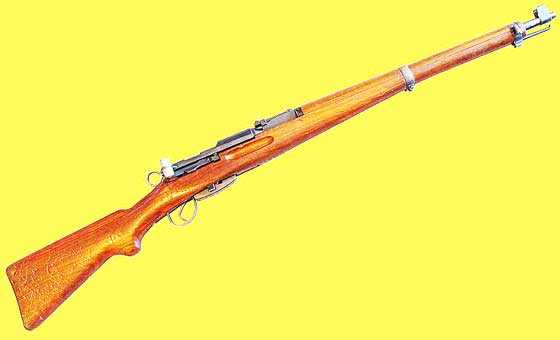
K31 Schmidt Rubin rifle is the platform for this Hammerli trainer.
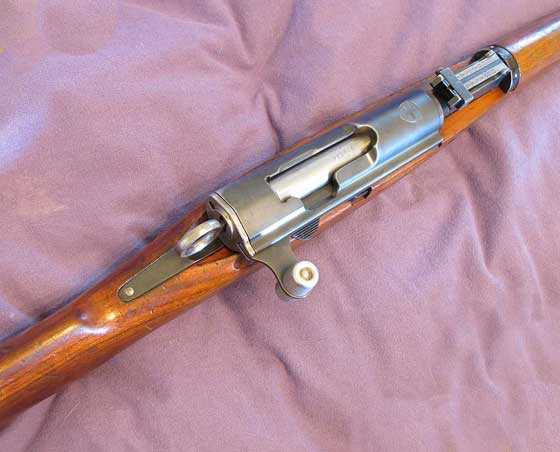
Instead of lifting that bolt handle, just pull it straight back.
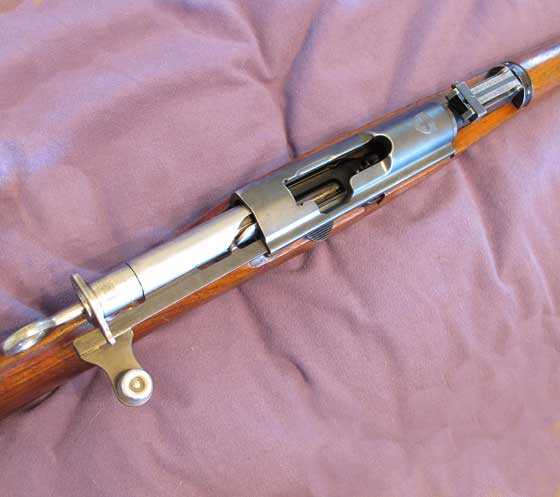
A cam rotates the bolt lugs out of engagement as the handle is pulled back. Rifle can also be manually cocked with the ring behind the bolt.
Trainer
The Hammerli trainer is a barreled spring-piston action that fits into the place where the K31 bolt normally lives. Remove the rifle bolt and install the trainer through the rifle breech and on out through the muzzle. The smooth bore of the trainer barrel fits inside the rifled barrel of the firearm so the lead ball never touches the rifling.

The trainer is a complete spring-piston air rifle that slips inside the K31 action and barrel. It interfaces with the K31’s trigger, but uses its own self-contained cocking system.
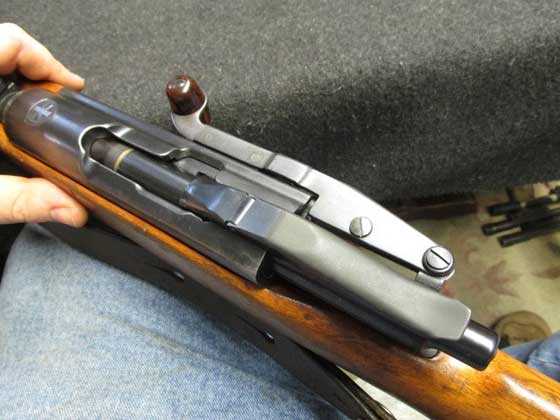
When the trainer is installed, it looks like the bolt of the rifle and operates the same way.
Caliber
Smith writes that the trainer fired precision steel balls of .175 caliber. He calls them air rifle shot. Well, .175 hasn’t been the air rifle shot size since the middle 1920s, and this trainer was made in the 1950s or later. So, one way or the other, he is incorrect. I hope to find out what’s right.
I plan to shoot 4.4mm lead balls, unless I can find a source for precision steel balls of the right size. RWS used to import them for the Diana model 30 gallery gun, so I might get lucky and find some in Europe.
The gun is a repeater that accepts from 1 to 6 balls. Each time the mechanism is cocked (by pulling the bolt straight back — just like the firearm), a ball is loaded into position for firing. The mechanism is a BB gun design, where the bolt tip starts the ball moving forward to about 50-75 f.p.s. before the air blast from compression hits it and accelerates it to its maximum velocity. But the velocity is low — I’m guessing in the 200-250 f.p.s. range with steel balls and probably below 200 f.p.s. with lead. Smith does say the velocity is 250 f.p.s. approximately, but he never tested one to know for sure. In his day (1956-57) people didn’t have regular access to chronographs.
Smith talks about this trainer as if it was the Daisy 499 of its day. It was made to shoot at 5 meters, and he mentions that the low velocity was extremely stable and the accuracy was astounding.
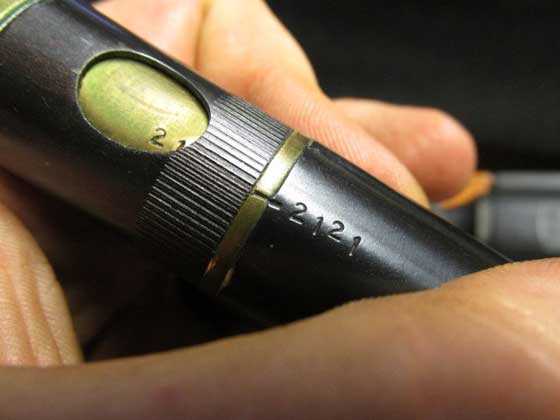
The loading port is accessed by rotating a knurled sleeve 90 degrees to the right.
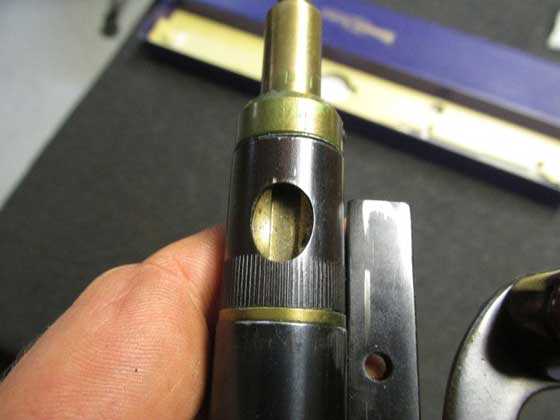
The sleeve is rotated to the right and you can see where the balls are loaded.
A major purchase!
I knew when I placed my bid that this was going to be a hot item. I was prepared to pay a lot for it because I will get so many articles from testing it. That was good because there was very stiff competition.
If I decide to sell it afterwards, I should have no problem getting my money back, because this trainer comes in a very fresh box! The only thing I think it’s missing is the instruction manual.

A pristine box adds value to the trainer.
As I mentioned, there are fairly well-documented sales figures for the pre-war Erma trainers. Prices start around $1,500 and go up over $2,500 if everything is present. In sharp contrast this Hammerli trainer has no real track record in the U.S. I would guess that it is better-known in Europe, where the majority of them probably still reside. It is a later production item, plus it was made for the Swiss rifle that has historically been used for target shooting rather than combat, so I would expect to see the trainers in excellent condition. The box was a welcome surprise, though.
Where we stand
I don’t have the trainer yet. The images I’m showing are the seller’s from his listing on the Gun Broker website. Since I now own the item I figure they are also mine. Because of the SHOT Show I asked the seller to hold off sending it until I return from Las Vegas at the end of this week.
The images of the K31 rifle are my personal rifle that I sold a couple years ago. I will borrow a K31 from my gun buddy, Otho, for this series and if I decide to keep the trainer, I will buy another K31 to go with it.
My plan is to do a regular detailed test of this trainer here on the blog. Since the mention in Smith’s book is the only information I have ever seen, my test results will expand the body of knowledge greatly for airgunners here in the States. Smith never shot a trainer, as far as I can tell. You readers are in for a treat!

Hi BB and the group. I am sure we will get some great posts about your new trainer. In this world of powder burners and airguns from all over the world it gets confusing to keep track of who made what and why. Case in point. I just ordered the Tanfoglio Limited Custom CO2 Pistol . One reviewer compared it to the CZ 750 SA, Internet searches of the guns showed me that Tangfolio made a clone of this weapon as at the time, CZ could not import them to the USA. I am somewhat familiar with Tanfoglio Witness c02 pistol as it seems to be a clone of the 1911 . Do you or any readers have the knowledge what would be the advantage of the Limited’s larger frame size ? It looks like it is real popular in Europe in competitive shooting. Enjoy the Shot Show.
Harvey
BB
I love this gun. I don’t care if it only shoots at 5 m.
Something about the military trainers get my blood pumping. But I really, really like how the action can be changed in the actual gun the soldier shoots. Way cool.
And the target shooting part. That’s interesting too. So does that mean the firearm action that was a target rifle was actually in a different stock then placed in a military stock? And ok I’m going to put a plug in here. And a modern slide in .25 caliber pcp conversion to train for longer range sniping. I guess the firearm could of been used for sniper purposes right?
Oh and the original box it came in. That is way cool too. When you find something like this for sale and even more so you get it. Does that still get you excited about the purchase you made?
And was going to say yesterday and it slipped my mind. I got your book with my recent pellet order. Absalutly love it. I’m getting ready to start chapter 7. The story’s are wonderful and the little lessons you throw in are great. I will re-read the book after I finnish it. That’s something I always did as a kid when I read books or magazine articles. It’s like there is something that is picked up on that you miss the first time.
If a person hasn’t got the book I strongly recommend that you do. Best 10 bucks I spent in a long time.
Oh and hope there is some things that are getting you excited at the show. Wish I was there to see it ALL. Can’t wait to hear about what you see.
GF1,
No, the K31 was never in a civilian stock. It was always a military rifle. But it has a free-floated barrel, which is unheard of. Most military rifles have their barrels anchored as tight as possible, so they can take the strain of fighting with a bayonet, but not the K31. It was made to be accurate.
In Switzerland all able-bodied men must serve in the military, as I understand it, and many of them keep their rifles in their homes — by law. They are encouraged and supported to shoot frequently, and they prize marksmanship. The K31 is an outgrowth of that national thinking.
B.B.
BB
Can’t wait to see how the tests go.
And what caliber or calibers did the firearm version come in?
7.5x55mm.
Reb
Yep just reread the report and seen that BB stated the firearm caliber.
Might be a fun gun to play with the.loads on.
Doesn’t the Lee-Enfield No. 4 Mk I have a free floated barrel? Would the K31’s free-floated barrel be a reason why it’s unsuitable as a military rifle? With accuracy and a fast action, it seems like it could be very good. I’ve also heard that the tight tolerances that go with accuracy might make it unreliable in combat. But I guess we’ll never know since it never was in combat. Looks like the firearm is a steal compared to the airgun trainer.
Matt61
LOL! Someone I know just bought a K31 this week. If I am not mistaken though, the one he bought was a good bit longer.
RR,
It it was longer it was 1911, not a K31. Or it could have been an 1889.
B.B.
That may be so. I was told it was a K31.
RR and BB
There are several differences but an easy way to identify is the location of the locking lugs. The K-31 lugs are at front of bolt whereas M1911 lugs are in the middle of its much longer bolt.
Decksniper
I’ve got a K31 complete with a saw tooth bayonet. Unfortunately but commonly neither the serial numbers on the gun nor bayonet match. A true frankengun.
I had no idea that Hammerli Trainer’s existed for this gun. Nice to learn something new everyday.
Quite a battle for this one on gunbroker since 10 people fought over it. Complete with the box blows my mind. What a find.
kevin
B.B.
I have seen these guns before (powder burners) but never paid them any attention. I had no idea they were that accurate. I always thought the Springfield was the best. Makes me want to buy one and reload ammo for it. Very good read. Thank You
Doc.
B.B.,
This trainer must be one of the coolest things I’ve ever read about on this blog, and that is saying quite a lot!
A (probably naive) question: Why is the actual firearm not especially useful as a battlefield weapon?
Michael
I’m guessing the free floated barrel makes it vulnerable as a battle weapon.
Michael,
Reb got it right. Although the rifle appears rugged, that free-floated barrel isn’t good in rough situations.
But the Swiss always thought defensively, so for them it was probably good.
B.B.
B.B. and Reb,
Got it. And as for being defensive and picking off the enemy from a distance, it is much better to be an archer than a pikeman.
Michael
B.B.
Oh, that’s a masterpiece! In fact – both are masterpieces in their own way. I wonder if such trainers could be made today for other popular platforms like Rem700, k98k or Mosin, for working out some basic skills and getting acquainted with rifle’s ergonomics.
Meanwhile, some pieces (not sure if they are master) from myself: http://i67.tinypic.com/eh53c.jpg
These are – 2 parts of receiver, bolt/bypass, bolt innards and flat triangular piece is bolt operation lever.
Overall project is going well, slow and steady wins the race, as always. There were some minor drawbacks with production, but now they being solved and things slowly but steadily come together.
duskwight
Duskwight,
Fascinating work. If I had a mill and lathe (and the skills) to do it, and the knowledge of all that is out there, I could see doing this myself. While the project progresses, it would be interesting to see the concept drawing of the final package. If that is out of the question, I understand. Really, very fascinating.
Best of luck as things continue,….Chris
I couldn’t get it to show me anything, twice.
How did you get it to work?
Reb,
I do not know. You use a phone, right? I got a laptop, so maybe that is the difference? The “site” was a bit “odd”, but it worked. I do not post pics, so I am not up on all that stuff. It was some nice shots of machined parts. Very cool stuff. Duskwight is doing what many of us would like to do,…..building a perfect airgun.
Reb
It came right up on my phone when I viewed it.
I finally found some images way down at the bottom but it was the back wheel and pipes on a motorcycle and some cartoons.
Reb
Sounds like your not leaving enough time for the page to load.
If that happens click out of it. Then click back on it. Then it will usually load up quicker the next time around.
GF1,
For sure. The laptop is the same. For being “smart”, these high tech. gadgets can seem pretty “dumb” at times.
Chris USA
Oh they can have a mind of their own that’s for sure.
And it’s always when you need them the most they seem to act up.
Tried it until my phone all but locked up, I’m gonna restart it and be back in a minute to try again.
Thanks!
Reb
When your on your phone are you using Wi-Fi or 3 or 4G.
I have better results if I turn the Wi-Fi off and use the 3G or 4G. But it also depends where I’m at and the signal I’m getting. But for the most part my Wi-Fi is off unless I can’t get 3G or 4G reception
I don’t have WiFi here so I leave it on for updates when I hit one but AT&T is throttling my data again.
;-(
Reb
Then that is probably it. Your running out of your data plan.
Not for sure. But we got satellite out where I’m at now. And it definitely you know what compared to cable.
Slooow motion is all I can say.
Duskwight,
If anyone can spot a masterpiece, it must be a master. You continue to amaze me.
B.B.
I meant to say that my main gripe against the K31 is that big ring at that back of the bolt that looks kind of silly. What was that for?
Excellent that the SHOT Show report will start tomorrow. This is an excellent chance to put our fingers on the pulse of the industry by predicting what is to come based on recent trends. Starting with firearms, the tactical trend is pretty clear. There are endless refinements of the AR platform. Otherwise, you have those strange hybrids of the assault rifle and pistol with a stock in the form of a brace over the forearm. I have no idea what those are for. And then there are the progressively smaller concealable handguns. What other tactical developments could there be? I would have said that I don’t know. But from a sneak peek at the SHOT show, it sounds like they are selling belt fed long guns! How is someone supposed to pay for all that ammo? 🙂
As for airguns, the big trends seem to be big bore guns and more pcps with different accessories. And there may be a small trend towards high quality springers like the Walther LGV. Thus are my predictions. We’ll see what B.B. reports tomorrow.
Reb, I was of the opinion that reloading will save money which is why I embraced it. It certainly can but there are some qualifiers that I was not aware of. There is a considerable start up cost in equipment (and learning). To pay that off and to realize the profits of reloading you have to shoot quite a bit which locks you into a commitment. Semiautos pose a real problem with the brass flying all over the place. I’ve given up trying to save my .45 brass. I couldn’t adjust my net properly. And with a semiauto rifle, you are limited to rested shooting to catch your brass. In offhand, which I prefer, my brass flies all over the scenery with no hope of recovery. And all this assumes you don’t have other restrictions on reloading connected to my living situation.
Still, I’m glad I did it for the learning process and the satisfaction of turning out rounds by myself.
Matt61
The closest I’ve ever gotten to reloading was my first BP revolver and it was fun but not many ranges allow it so I’m back to needing a place to shoot but I learned enough to find out what I want my next one to be.
I like the ring on the back!
I think it adds character and is a nice departure from the various shapes of knobs I’ve seen.
Matt61
I’m with Reb on the ring. Definitely unique.
Pretty sure its a cocking ring. Maybe easier to locate and pull quicker in a hectic combat situation than a bolt. Especially since no bolt lifting is required.
My thought anyway. I could be way off target if you know what I mean.
GF1,
You?,…off target?,….me thinks,…..NOT! 😉 The stop mod. was a good excuse to use the bunged up JSB’s. They still shoot good at 41′. 50 shots at one target and never bigger than 1/2″ on 1 bulls-eye. Plus, they are good for just keeping the “feel and cycle” of the 2 rifles. They will be gone,…. quick.
Chris USA
Ain’t that crazy how they still shoot good.
If somebody told me that before I tryed. I would of told them they were full of bull.
I get dented tins sometimes when I receive my pellet orders. Right off the bat my brain makes me get paranoid that the pellets won’t shoot good. But the pellets on the target prove me wrong. Which I’m glad of. Now before I think they are bad I shoot and see. Have not been disappointed in their performance yet.
Ain’t it funny how the mind can mess with ya. Just one more reason to go by statistics than what ifs. You know what I mean.
GF1,
Yea,…the skirts were the worst. But,….those “blow out” pretty well and still do the job. Short of the perfect pen size, a .22 clamped in a small pair of vice grips, rounds out the skirts just fine. The barrel takes care of the “final” sizing. For sorting,…the head size seems to be the ticket.
And YES,….the mind!,…..well,….that bad shot could not have been me,….right? Truth told,…it is usually me. I may not know how,…or why,…yet,….but another 10,000 shots and I am pretty sure I will have it figured out. 😉
Chris USA
I have got those dented tins and just dreaded shooting them. I would open them and see if I could see damaged pellets. Even if I didn’t I would have in my mind they wouldn’t shoot good out of my guns.
Then I would even take a permanent black marker and put a big dot on the lid of the tin of pellets. Then I would start getting low on pellets and only have those dented marked tins left. So I had no choice but to shoot them till I got more ordered.
They always shot good. So now if I get any dented tins I just shoot them right off the bat. And they always have produced good results.
So now I keep my mind out of that part of shooting. I just shoot and see what happens before I assume something will happen. It is ems to work out better that way.
I asked for a 10% discount on the last tin of Stoeger X-match and I only found a couple initial culls and I still trust the last 25 or so that I have left.
It should make it very easy to control a decock.
BB, More smoothbore BB gun testing results:
I realized that all of my testing was at relatively low velocity. I decided to test the 760 with 10 pumps (around 595 fps) at 5 meters. With unsorted Umarex BB’s five consecutive 5 shot groups the average was .412 inch. With Umarex sorted to 4.43 mm the group was .375. Compare this to an average of .577 for sorted Umarex at three pumps. No oil was added. Umarex BB’s seem to be oily as they are, which might explain their usual good performance along with their consistent size and smoothness.
A possible reason for this might be that the air blows by the BB and helps keep it centered. Gunfun1 mentioned this with a ball being centered in a verticle tube in an airflow. Since the BB barrel is horizontal a higher velocity might be needed. (The Gunfun effect!)
I triedthe smaller Copperhead BB’s sorted to 4.36 mm. The groups were over an inch so it seems a tight fit is necessary. Much more to be learned! But remember this is for a 760 shooting BB’s! Not that far from 499 performance!
Fido3030
Fido3030,
Thanks for the update! The 499 is a low velocity gun (as are most high end target pellet rifles). But you may be right on the tighter fitting barrels for bb guns. I am trying a thinner oil. 3-IN-ONE Multi-Purpose PTFE Lubricant. Sponge application. Working good so far. Only 1-2 bb’s did not make it all the way down on the 499. I figure they were bigger sized, but no gauge to check. A pull of the cocking lever “sucked” them right down. Will keep you posted. I will see how long I can shoot the lubed bb’s before any “sticking” shows up, if at all. Pellgun oil is too thick, I think. Very cool on the Umarex showing the least O.D. spread.
As for clean bb paper punching,…..electrical tape was the most precise. Plastics seem to be the key. I will try clear sheet protectors next, with targets inside. I will keep you posted.
As for testing, back it up a few and see what that does. The results will still be good, just a bit more obvious due to a bigger spread. Just an idea.
Thanks for all your work, and keep us posted,….Chris
Fido3030
The Gunfun effect. I don’t even want to think about where that could go. 😉
But I believe you are on to something shooting the oiled bb out of your 760 pumper. I think the velocity control we help fine tune the bb’s movement down the barrel.
You don’t have a twist rate and lead or a skirt to get the projectile moving. So you need to have something to help seal the bb to the bore.
Fido and GF1 –
I remember a couple weeks back you were talking about this vertical airflow meter. I’m fairly certain that the tube is -very- slightly tapered, wider going up, so that for any airflow, there is a stable position for the ball supported by the air pressure. Otherwise, what would make the ball stop at any one height? If the tube was a constant diameter, the ball would just get pushed out the top, or never start to rise at all.
Gerhard_k
You might be right. Never had one cut in half to see.
But I think the rise of the ball is controlled by how much air leaks past the valve seat seal we test at work. So if it was a excessive valve seal leak the ball would rise all the way to the top of the tube.
It doesn’t test air flow. Well in a sense it is air flow. But its a minimal amount. The idea of the gauge at work is that the ball should not move. That would be a good sealing valve. But if the ball does move there is a leak or incomplete seal. The more the ball moves the more of a leak.
I guess the thing about it all I was trying to make a example of how the air flowed to keep the ball centered in the tube. That is the most important thing that relates back to the way a bb moves in a barrel with air pressure.
Matt61–That ring is the safety. Some Moisin-Nagant owners are adding a similar ring to their cocking piece knob. As issued, the MN safety is almost impossible to use. The ring gives enough leverage to allow the shooter to use it (unless he (or she) has a long nose and is a stock crawler. As issued, the 1903 rifles can also be a problem to these shooters. Ed
Ed
Look at BB’s pictures descriptions above.
He states the ring is used to cock the gun.
But maybe it is also the safety when its pulled. ???
Matt61– Re brass from semi-autos, You should see what happens at matches. As soon as the stage (slow, timed or rapid) is over, and the line is safe, all the reloaders go forward and there is a scramble as they try to pick up as much brass as possible. Naturally some pick up more brass than others, but it is part of the game. Marking your brass with a distinctive color helps, somewhat. Usually the reloaders use their hats as baskets, when they collect the cases. Ed
Ed
Is there not catch bags for the guns?
I made one for my semi auto rifles.
And my guns are side eject. Those guns top eject possibly that your talking about? Maybe harder to have a catch bag.
GF1—I have never seen a catch bag for an M1 Garand, M1a(M14), or 1903 and similar rifles. If they did exist, no one would use them in a match-they could cause jams, they would make clearing a jam difficult, they might slowdown reloading. Catch bags work best on firearms that have a narrow ejection port like the AR,s. No one should use them in a match or while hunting. The work best on a practice range where any problems that they might cause can be fixed without losing points or game, Re the ring on the Swiss straight pull rifles——Pull the ring back, twist the ring to the left, you have just engaged the safety. Pulling the ring back will cock an uncocked Swiss rifle, so it can be used if you get a misfire. It does get cold in Switzerland, and the soldiers wear mittens. This can make the ring difficult and slow to use. The trigger guard is also rather small for a rifle intended to be used in cold weather, this is a fault common to many military firearms. Ed
GF1–I just checked my copy of “Testing the War Weapons”==Tim Mullin–and he reports that the ring safety can be used by a gloved hand, He also writes that the trigger guard is “somewhat small for mittens”. No comment re the safety while wearing said mittens. BB–Do you have a pair of mittens? If you do, please try engaging the safety while wearing them, and let us know if it is possible. I am not suggesting that you place your mittened hand in the freezer for an hour or so, but it might make for a more realistic test condition. Ed